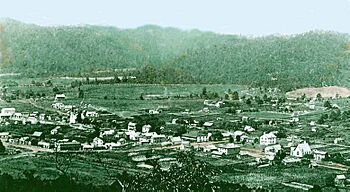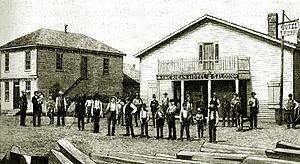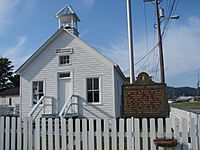Morehead, Kentucky facts for kids
Quick facts for kids
Morehead, Kentucky
|
|
|---|---|
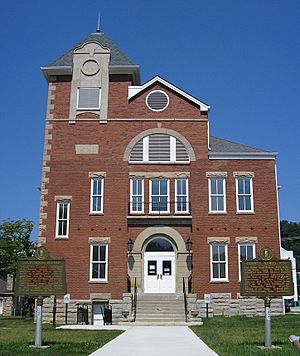
Rowan County Arts Center in Morehead. (Formerly Rowan County Courthouse)
|
|
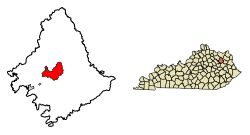
Location of Morehead in Rowan County, Kentucky.
|
|
| Country | United States |
| State | Kentucky |
| County | Rowan |
| Incorporated | 1869 |
| Named for | Gov. James Morehead |
| Area | |
| • Total | 9.72 sq mi (25.17 km2) |
| • Land | 9.60 sq mi (24.88 km2) |
| • Water | 0.11 sq mi (0.30 km2) |
| Elevation | 997 ft (304 m) |
| Population
(2020)
|
|
| • Total | 7,151 |
| • Estimate
(2022)
|
6,734 |
| • Density | 744.59/sq mi (287.47/km2) |
| Time zone | UTC-5 (Eastern (EST)) |
| • Summer (DST) | UTC-4 (EDT) |
| ZIP code |
40351
|
| Area code(s) | 606 |
| FIPS code | 21-53418 |
| GNIS feature ID | 2404299 |
| Website | morehead-ky.gov |
Morehead is a city in Rowan County, Kentucky, United States. It's located along US 60 and Interstate 64. Morehead is the main city and center of Rowan County. In 2020, about 7,151 people lived there.
Morehead was important during the Rowan County War. It is also home to Morehead State University.
Contents
Morehead's History
Early Settlement in Morehead
The first European settlers arrived in Rowan County after the American Revolutionary War in 1783. Morehead was founded in 1854 by Colonel John Hargis. He bought land in the area and started the community. The city was named after James T. Morehead. He was the governor of Kentucky from 1834 to 1836.
Rowan County was created in May 1856. It was formed from parts of Morgan and Fleming counties. Morehead became the county seat because it was centrally located. This made it an important city, even though it was smaller than Farmers. Morehead officially became a city in 1869.
The Rowan County War
In the 1880s, Morehead was the scene of a famous conflict. It was called the Rowan County War. This conflict involved several families and groups. It started with a fight on election day. Over the next few years, many gunfights happened. At least 20 people were killed.
One group, led by Craig Tolliver, took control of the town. They put their friends in important county jobs. People from the other side were arrested. Some were even killed. The conflict became known across the country. The governor sent troops twice to help, but it didn't stop the fighting.
Finally, a large group of about 100 people formed. They were led by Daniel Boone Logan. They had the support of the governor. There was a big gun battle in Morehead. Several members of the Tolliver group, including Craig, were killed. This ended their control of the county.
Morehead State University was started because of this conflict. After the state militia helped restore order, a church group opened a school. This school later grew into the university.
Morehead in the 20th Century
In the early 1900s, Morehead's industries grew. It became an important shipping center. The city had a lot of lumber, fire clay, and farm products. This made it a busy place for business. The nearby Licking River also helped the city grow.
By the 1920s, the city focused more on getting fire clay. This was because timber prices were falling. In 1929, the Midland Trail connected to Morehead. This was one of the first major roads across the US.
In July 1939, a big fire damaged many businesses on Main Street. The town's unique pack horse library also burned down. Just a day later, severe flash flooding hit the town. Many people were affected. The floods caused a lot of damage to homes and farms.
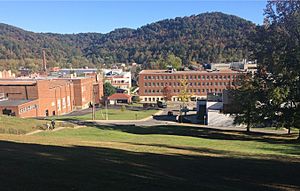
In the early 1960s, Morehead worked to get a local hospital. St. Claire's Medical Center opened in 1963. It started with 41 beds. Transportation improved in 1969 when Interstate 64 was completed. This made it easier to travel to and from the city.
After logging and mining slowed down, Morehead focused on education. They invested in Morehead State University. This helped the city's economy grow. Morehead also worked to attract tourists. Hiking trails were made around Cave Run Lake in the 1960s and 1970s. In 1974, Cave Run Lake was made bigger. By 1990, Morehead State University was the city's largest employer.
Morehead in the 21st Century
The Downtown Morehead Historic District was added to the National Register of Historic Places in 2022. This means it's recognized for its important history.
Morehead's Geography
Land Features of Morehead
Morehead is about 9.3 square miles in total area. Most of this area is land. The city is located in the foothills of the Appalachian Mountains. The land here is a mix of rolling hills and the edge of the Eastern Kentucky Coalfield. The highest point nearby is Limestone Knob, which is 1,435 feet high. The city itself is about 748 feet above sea level.
Morehead's Climate
| Climate data for Morehead, Kentucky | |||||||||||||
|---|---|---|---|---|---|---|---|---|---|---|---|---|---|
| Month | Jan | Feb | Mar | Apr | May | Jun | Jul | Aug | Sep | Oct | Nov | Dec | Year |
| Record high °F (°C) | 80 (27) |
81 (27) |
89 (32) |
93 (34) |
95 (35) |
104 (40) |
105 (41) |
106 (41) |
103 (39) |
96 (36) |
85 (29) |
79 (26) |
106 (41) |
| Mean daily maximum °F (°C) | 41 (5) |
47 (8) |
57 (14) |
67 (19) |
76 (24) |
84 (29) |
88 (31) |
87 (31) |
80 (27) |
69 (21) |
57 (14) |
47 (8) |
66.7 (19.3) |
| Mean daily minimum °F (°C) | 22 (−6) |
24 (−4) |
32 (0) |
40 (4) |
50 (10) |
59 (15) |
63 (17) |
62 (17) |
55 (13) |
42 (6) |
35 (2) |
27 (−3) |
42.6 (5.9) |
| Record low °F (°C) | −28 (−33) |
−19 (−28) |
−9 (−23) |
16 (−9) |
25 (−4) |
35 (2) |
43 (6) |
35 (2) |
29 (−2) |
13 (−11) |
0 (−18) |
−24 (−31) |
−28 (−33) |
| Average precipitation inches (mm) | 3.40 (86) |
3.27 (83) |
4.07 (103) |
3.91 (99) |
4.86 (123) |
4.55 (116) |
5.60 (142) |
3.78 (96) |
3.23 (82) |
3.16 (80) |
3.47 (88) |
4.03 (102) |
47.33 (1,202) |
| Source: The Weather Channel. | |||||||||||||
Morehead's Population
| Historical population | |||
|---|---|---|---|
| Census | Pop. | %± | |
| 1880 | 163 | — | |
| 1890 | 491 | 201.2% | |
| 1900 | 1,100 | 124.0% | |
| 1910 | 1,105 | 0.5% | |
| 1920 | 981 | −11.2% | |
| 1930 | 825 | −15.9% | |
| 1940 | 1,901 | 130.4% | |
| 1950 | 3,102 | 63.2% | |
| 1960 | 4,170 | 34.4% | |
| 1970 | 7,191 | 72.4% | |
| 1980 | 7,789 | 8.3% | |
| 1990 | 8,357 | 7.3% | |
| 2000 | 5,914 | −29.2% | |
| 2010 | 6,845 | 15.7% | |
| 2020 | 7,151 | 4.5% | |
| 2022 (est.) | 6,734 | −1.6% | |
| U.S. Decennial Census | |||
In 2020, Morehead had a population of 7,151 people. The city has grown a lot since its early days. For example, in 1880, only 163 people lived there. The population has changed over the years, with periods of growth and some smaller declines.
Fun Things to Do in Morehead
In 1974, Cave Run Lake became a big attraction. It's the largest lake in Eastern Kentucky. Cave Run Lake is also known as the "Musky Capitol of the South" because of its fish. A group was formed in 1991 to help bring more businesses and tourists to the area.
There are many hiking trails around Cave Run Lake. These trails have been used since the 1960s and 1970s. Morehead also became a "trail town" in 2012. This means the Sheltowee Trace Trail goes through the city. It lets hikers explore the town and get supplies. There are over thirty cycling trails in the county's part of Daniel Boone National Forest.
Education in Morehead
Morehead has several public schools for students. These include:
- Clearfield Elementary
- Bluegrass Discovery Academy
- McBrayer Elementary
- Morehead Youth Development Center
- Rodburn Elementary
- Rowan County Middle School
- Rowan County Preschool Center
- Rowan County Senior High School
- Sunrise Children's Services
- Tilden Hogge Elementary School
The city is also home to the Craft Academy for Excellence in Science and Mathematics. This program lets talented high school students take college classes at Morehead State University. They can earn college credits while still in high school.
Morehead has two places for higher education. Morehead State University was founded in 1887. It offers many different degree programs. There is also a campus for Maysville Community and Technical College in the city. Morehead also has a public library, the Rowan County Public Library.
Morehead's Media
Newspapers
- The Rowan County News (Started in 2020)
Radio Stations
- W219DI 91.7 - Freedom Radio FM, a Christian radio station
- W227AX 93.3 – K-LOVE, a contemporary Christian radio station
- WIVY 96.3 – Known as "IVY," playing timeless favorite songs
- WMKY 90.3 – Morehead State Public Radio, an NPR station for eastern Kentucky
- WMOR-FM 106.1 – An adult rock radio station
Sister Cities
Morehead has partnerships with other cities around the world:
 Yangshuo, Guangxi, China (since 1994)
Yangshuo, Guangxi, China (since 1994) Ballymena, Northern Ireland, United Kingdom
Ballymena, Northern Ireland, United Kingdom
Images for kids
See also
 In Spanish: Morehead (Kentucky) para niños
In Spanish: Morehead (Kentucky) para niños


